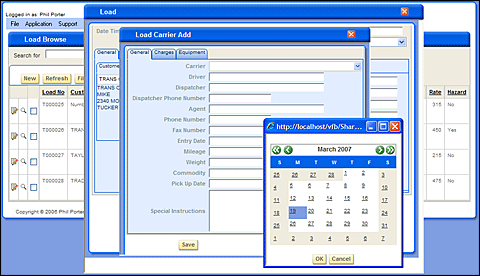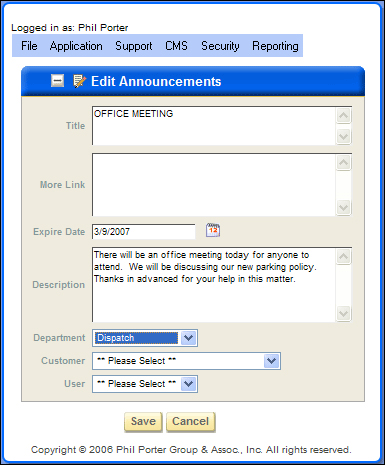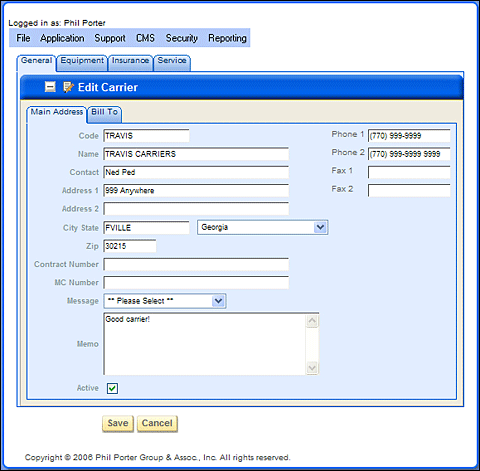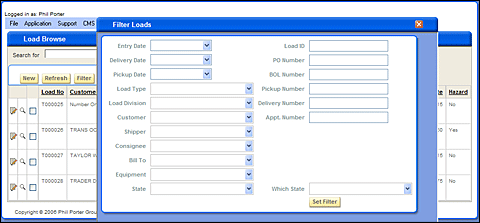| PPG&A, Inc. |
| Visual Freight Broker |
"The price of Iron Speed Designer is worth the framework that comes
with it alone."
- Phil Porter, President of PPG&A, Inc.
|
|
|
Visual Freight Broker |
PPG&A, Inc.
Atlanta, GA USA
Chicago, IL USA
|
The Visual Freight Broker (VFB) application was developed by PPG&A, Inc. to resell to
clients in the freight brokerage industry who are looking for a web-based application.
Freight brokers manage transport logistics by formulating a relationship between their customer
and a particular carrier.

VFB Load Browse allows the user to access detail drilldown capabilities without
leaving the browse form. AJAX enabled pages update content as the user steps back to
the previous form.
The VFB application manages the movement of freight from origin (shipper) to destination
(consignee). For example, a broker can use VFB to enter and track the details of a load
that needs to be moved across the country. The broker can also use the custom tools built
into the application to identify a carrier to haul the load.
VFB maintains information about customers, shippers, consignees, carriers, equipment, services,
messages, and various other entities. Users enter new and recurring freight loads into VFB early
in the morning. Next, dispatchers begin matching customer loads with carriers using various tools
within VFB. Dispatchers negotiate specific rates with each individual carrier in order to make a
profit on the load. Loads have various characteristics that can be used to manage them through the
entire transportation cycle. Application users can set these in VFB or VFB will do this automatically.
After loads are completed, they still have value; this trait allows VFB to recompile load details in
order to help the users match loads with carriers.
It is very important for each freight broker to navigate and query the data within VFB.
Profitability is determined by the team's ability to handle a large number of loads in a short
period of time.
|
Application size and scope |
The ability to create new database tables and base web pages quickly was a key factor
in deciding to use Iron Speed Designer. The tool's framework gives you the ability to build
base forms quickly and then, with the extensibility of Iron Speed Designer, create sophisticated
user interfaces. Integration of third party controls and reporting systems were pivotal to the
application development.
The VFB application was ported from a legacy Windows desktop application, and our customers
expect the same ease-of-use. Incorporating newer technology such as Iron Speed Designer and
compatible third-party tools allowed me to create a new VFB application that meets and exceeds
the flexibility of the original desktop app. With the openness of Iron Speed Designer's framework,
I was able to implement these new technologies with little effort.

The standard Iron Speed Designer forms were used without any modifications
throughout the application.
The size of the database, number of web pages, users per application month, and transactions
per month vary greatly depending on the particular customer using VFB. Supporting tables such
as Carriers has as many as 10,000 records. However, the primary load table could maintain
100,000 records and more depending on the amount of activity over a period of years.
Generally, the application accesses one Microsoft SQL Server database per customer. There are
situations where there could be more than one. The application uses 35+ database tables and
approximately 200+ web pages. Both of these entities continue to grow each month as additional
functionality is added to the application.
|
The project |
Since I developed and sell VFB, I have to deliver an application that's as good, or
better, than the original application I sold the client. The demand is driven by what
the client wants to see. As the software evolves, a new version is rolled out to all
customers. Producing changes in this product affects each and every one of my customers.
For this reason, it is very important that the basic framework of the product is solid.

In the Carrier Add/Edit forms data and data tables were grouped into related tabs.
With an implementation team of three (one Developer and two Testers), the VFB application
took a total of eight months to get to pre-production stage. I spent a majority of my development
time going through the application and trying different things, implementing custom code extensions,
deciding which third-party tools to integrate, and learning the best ways to implement different
functionality.
|
Code extensions and customizations |
With the extensibility of Iron Speed Designer through object-oriented programming, there
were many ways to customize the application. Standard out-of-the-box code customizations
from the Code Customization Wizard in Iron Speed Designer were used, and in many cases, were
the basis for other code customizations.

Filtering forms allow compound filtering of load detail. Since the load browse form is
AJAX enabled the form is updated without the usual post back form flash.
|
Layout customizations |
In many cases, I need to change the page layout and navigation to accommodate some of
the form drill down capabilities needed within the application. This varies greatly
depending on the complexity of each form. However, in some cases, I am able to use a standard
Iron Speed Designer template. I've worked with the Mt. Redmond design theme several times.
I like this color scheme because it coordinates with the Infragistics themes.
I created various overrides to implement custom code within specific table and record
controls. I also write a lot of custom JavaScript on the client side, making the application
work for them. Integrating third-party tools, including Infragistics, ActiveReports, and
AJAX was straightforward once an understanding of the framework was achieved.
|
Iron Speed Designer impact |
Without the impact of Iron Speed Designer, working by hand, the project would have required a
minimum of 30 percent more time. Keep in mind that these numbers are an approximation,
and they account for any learning curve and in working with other third-party tools.
The time saved in automatically creating SQL statements in one click alone is immeasurable.
If I had to sit down and write every line of code, it would be tremendous. While this project
would have been feasible without Iron Speed Designer, there is no way that I could have come
up to speed as quickly as I did. Once I understood the capabilities and the framework of the
tool, I was really able to ramp-up quickly!
This tool is incredibly cost-effective! It is especially important for small shops like
mine to consider the total costs of a development tool, including both short-term (purchase
price) and long-term (development time, subscription renewals, and support). The price of
Iron Speed Designer is worth the framework that is constructed in the application
alone. I would have spent more time building my framework within ASP.NET than I have spent
on all the other items to date.
In addition to VFB, I have built a series of simple applications, including labor tracking
systems and work order systems; however, none of these applications were nearly as extensive
as VFB, and I was able to complete them in under a week.
|
Next steps |
The VFB application continues to evolve and grow with my customers. Incorporating extensible
style sheets (XSLT) into my Iron Speed Designer application is also a possibility. This will
allow data to be displayed differently for individual users. By manipulating style sheets, I
can also utilize one form to display a variety of reports.
Another step is to incorporate EDI capabilities and content collection from related sites to
augment standard data entry.
|
About the developer |
Phil is the President of PPG&A, Inc. He is a self-taught software developer with over
20 years of application development experience.

|
|
|
|
|
|
|
